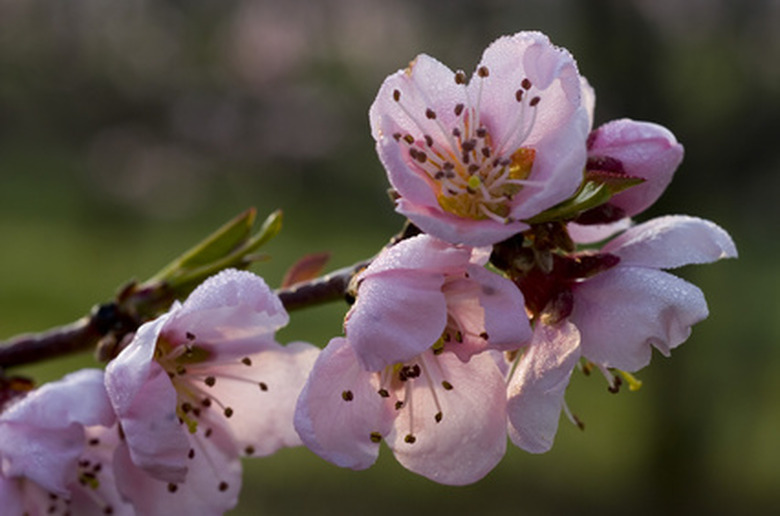Growing Peach Trees In Utah
Grown throughout the United States for several centuries, the peach tree is believed to be originally from Asia. This often troublesome to maintain fruit tree is also regarded as a highly versatile fruit since it can be eaten raw, canned, made into desserts or even into jams or jellies. Peach trees are grown extensively in Utah and are considered one of the most popularly grown fruit tree. To have success growing a peach tree in Utah requires some preparation and considerable maintenance. But the reward is a bountiful harvest of sweet, juicy peaches.
Step 1
Prepare the planting area by turning over the soil with a shovel, a garden fork or a rototiller, if you have one. Dig the soil up to a depth of between 12 and 14 inches. For each peach tree you are going to plant, make sure you dig up the area to a diameter of between 5 and 6 feet. The University of Utah recommends planting a peach tree in full sun, on a slope (if possible), which can help make the cold air drain away.
- Grown throughout the United States for several centuries, the peach tree is believed to be originally from Asia.
- To have success growing a peach tree in Utah requires some preparation and considerable maintenance.
Step 2
Spread out over the cultivated area a 3- to 4-inch layer of compost, manure, grass clippings, rotted leaves or other similar organic media to help improve the drainage of the soil. Mix the organic media into the soil thoroughly. According to LaRane Bautner of Millcreek Gardens in Salt Lake City, peach trees grow best with well-draining soil.
Step 3
Dig a planting hole in the center of the prepared area that is twice the diameter of the peach tree's root system, but approximately its same depth.
Step 4
Set the bare-root peach tree into the planting hole. Spread out its root system into the soil.
Step 5
Hold the peach tree vertical in the planting hole. Locate the bud union on the peach tree. This is typically indicated by a slight bulge where the trunk of the tree meets the root system. Plant the peach tree so the bud union is 1 to 2 inches above the level of the surrounding soil. Essential for success when growing a peach tree is to make sure it is not planted too deeply in its planting hole.
- Spread out over the cultivated area a 3- to 4-inch layer of compost, manure, grass clippings, rotted leaves or other similar organic media to help improve the drainage of the soil.
- Plant the peach tree so the bud union is 1 to 2 inches above the level of the surrounding soil.
Step 6
Scoop soil on top of the root system to fill the planting hole about two-thirds full of soil. Pour water into the planting hole until it's full. Finish filling in the planting hole with soil once all the water has dissipated.
Step 7
Prune back the bare-root peach tree to between 24 and 36 inches in height. Remove any broken branches or side branches that might be forming at the base of the main trunk.
Tip
Make sure you choose a variety that can withstand the cold temperatures of Utah. Several varieties can withstand temperatures of down to -25 degrees F. Plant bare-root peach trees from December through February. Peach trees grow best when given a soil pH of 6.5. Ohio State University suggests preparing the planting area one to two years in advance. This will allow you plenty of time to make the necessary adjustments to the soil to ensure optimum fruit production of the peach tree.
Things Needed
- Peach tree
- Shovel
- Organic matter
- Snips
